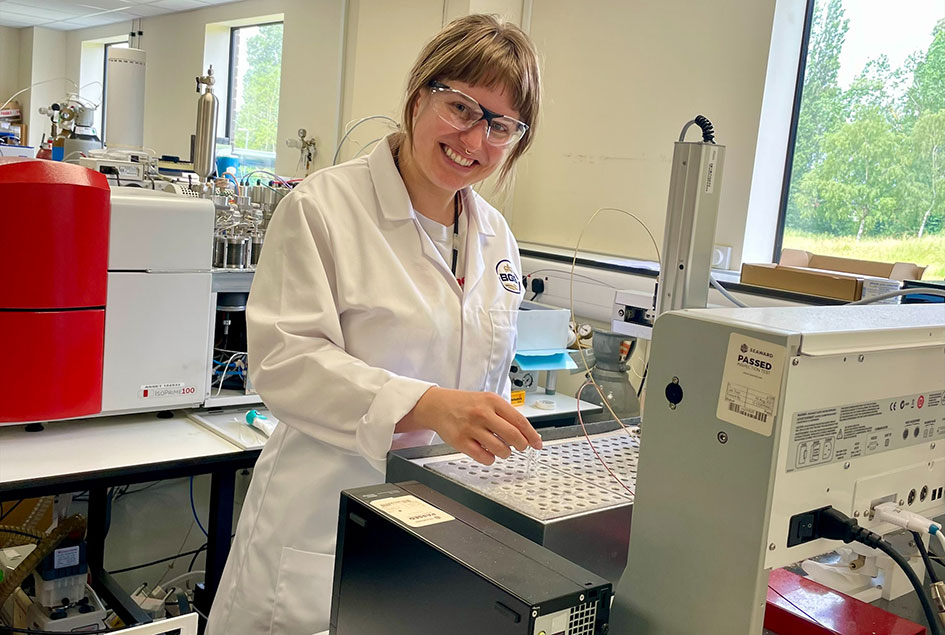My experience as an international PhD student visiting BGS
PhD student Vanessa Nowinski describes her experience in the stable isotopes labs at BGS, while working on the famous Lake Suigetsu.
17/07/2023 By BGS Press
My name is Vanessa Nowinski and I am a PhD student from the University of Adelaide in Australia. I recently had the opportunity to visit BGS as part of my PhD training via a grant from the Australian Research Council.
The primary focus of my research is unravelling the mysteries of the past, specifically through analysing lake sediments from the very famous Lake Suigetsu in Japan. The lake is recognised for its remarkable chronology spanning an impressive 70 000 years, with many of the individual years being represented by a single layer of sediment. My PhD research involves reconstructing the palaeoclimate of the East Asian monsoon from the chemistry of these layers, specifically the stable isotopes.
The oxygen isotope composition of siderite (iron carbonate), a mineral abundant in Lake Suigetsu’s sediments, is a function of the source of the air masses that bring rainfall to this part of Asia. We can use this to determine information about the strength of the East Asian monsoon in the past. Understanding the East Asian monsoon is vital in predicting future climate patterns that affect nearly half of the global population.
With zero prior experience in stable isotopes, I started my internship at BGS filled with a mixture of excitement and trepidation. However, any apprehension I felt quickly dissolved as I was welcomed by a team of brilliant researchers and technicians who were eager to guide me through the intricate process of analysing oxygen isotopes from the siderite.
Immersed in BGS’s world of cutting-edge mass spectrometry at the Stable Isotope Facility at BGS (part of the National Environmental Isotope Facility), I discovered an appreciation for the wonders of scientific technology. The ability to discern stable isotopes within the siderite allowed me to unravel the palaeoclimate patterns hidden within the lake sediments, providing a window into the climatic history of the East Asian monsoon.
Beyond the scientific discoveries and technical skills acquired, my time at BGS gifted me with something invaluable: a sense of belonging within a vibrant scientific community. Every conversation and interaction fuelled my passion and expanded my horizons. Engaging with fellow researchers and immersing myself in the knowledge hub of BGS nourished my intellectual curiosity, broadening my understanding of the intricate web of Earth’s systems. While I was visiting BGS we marked International Women in Engineering Day and it’s safe to say there are many great women scientists, technicians, engineers and women in other roles at BGS. This has motivated me to pursue my scientific ambitions with confidence, reminding me that gender should never limit one’s potential in pursuing one’s passions.
Overall, my visit to BGS was very positive and productive and I took most of my data home with me! I had the opportunity to work with experienced scientists including Jack Lacey, Kotryna Savickaite, Harvey Pickard and Carol Arrowsmith: I thank them for their kindness and support during my stay. Special thanks go to Melanie Leng for hosting me as a PhD student. I would also like to thank my PhD supervisors Dr Jon Tyler and Dr John Tibby at the University of Adelaide for the opportunity to visit BGS, for providing the lake sediment samples and for financial support to carry out the analysis.
I can only encourage other students from the UK and other countries to apply for scholarships at BGS. The experience and knowledge gained at the BGS improved my understanding of stable isotope analysis and palaeolimnology, which will significantly contribute to my PhD thesis.
About the author
Vanessa Nowinski is currently a PhD student at the University of Adelaide, investigating the palaeoclimates of Lake Suigestu in Japan.


